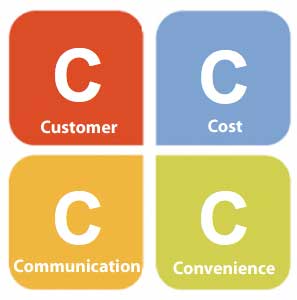Although I’ve been working in marketing for almost 30 years and I’ve taught college level marketing courses, I’ve never, ever taken a single course in marketing. I’m a learn on the job, self-taught kind of guy.
I remember very clearly one of the first things I learned on the job that I would have learned if I had ever taken Marketing 101: the Four P’s. You remember them. Product, Price, Place, Promotion?
It’s such a powerful concept, the marketer as the wizard behind the curtain, pulling these four levers and causing the market to dance to his tune.
Too bad it’s not true.
Probably it was never true, but certainly today no marketer can make customers purchase in this simplistic, manipulative way. It’s time to retire the Four P’s.
As long ago as 1990, Robert Lauterborn, a professor of advertising at the University of North Carolina, proposed an alternative: the Four C’s.
Customer Wants and Needs Replaces Product
Forget about your product for a moment, and focus on the customer. What do they want and need? What problem(s) can you solve for them? How do you solve it completely, in a way that delights the customer?
Cost replaces Price
The cost to the customer to satisfy their wants and needs may be much more than just your price. If your product is so difficult to install and configure that it requires thousands of dollars of consulting time, the initial costs are much greater than your price. The total cost of ownership over the life of the product is much greater than your price. Checking at that big bank may be free, but if you’re charged a fee for every ATM withdrawal and every time your balance drops below $500, the cost is much greater than that free price.
Convenience replaces Place
Amazon is the master of this. They’re not just about place; anyone can set up shop on the Internet and sell in the same “place”. Amazon is all about convenience: 1-click purchasing, free two-day shipping, no questions asked return policy.
Communication replaces Promotion
Promotion is one-way. Communication is two-way. Promotion is shilling. Communication requires engagement. Communication is authentic. Promotion is false.
The Four C’s and Agile Marketing
Agile Marketing is much more consistent with the philosophy of the Four C’s than the Four P’s. Agile Marketing requires a focus on the customer, and their wants and needs. Agile Marketing requires engagement and transparency over official posturing and spinning. Agile Marketing encourages collaboration, not only internally, but with the customer.
So forget the Four P’s, and start applying the Four C’s.





The 4 C’s definite resonates with me, from the customer’s vantage point. Very true, and thanks for sharing
Thanks, Jack. One of the major reasons that business schools still teach the Four P’s is that one of the originators of the Four P’s, Philip Kotler, is also the leading marketing textbook author.
Jim
Now where’s the customer value in that?
I think I’d add another “C” – Customer care.
The costumer care is part of the communication. It includes the after sale process, which is part of the customer retention and long term engagement.
The 4 C’s definite resonates with me, from the customer’s vantage point. Very true, and thanks for sharing
Thanks, Jack. One of the major reasons that business schools still teach the Four P’s is that one of the originators of the Four P’s, Philip Kotler, is also the leading marketing textbook author.
Jim
Now where’s the customer value in that?
I think I’d add another “C” – Customer care.
Philip Kotler maybe helped to make it popular but the invention of the 4P’s has been attributed to E. Jerome McCarthy.
Pingback: The Four C's - Agile Marketing.Net | Lean and enterprise 2.0 | Scoop.it
Pingback: The Four C's - Agile Marketing.Net | Lean and enterprise 2.0 | Scoop.it
Pingback: Price, Probit and Logistic Regression | Focus Product Marketing
Pingback: Price, Probit and Logistic Regression | Focus Product Marketing
The 4Ps comes from the B2C world and is still valid for the most part. From a B2B perspective the 4Cs makes sense.
From a B2C perspective
In the world of Web 3.0, social media, I see the point of 2 way communication replacing the 1 way communication, also this provides a personal touch. This doesn’t replace promotions however.
Also with companies investing millions on big data analytics to understand customers there is a great amount of information available to understand the customer issues and problems. Customer needs and wants needs to be understood however it doesn’t replace product.
Rather than think about cost and price, think about value to the customer. The price of the product is the value that is captured. Also need to think about reference pricing. So an IPAD costs 499 regardless of the generation. The thing the customer needs to think is do I need it now or can I wait for another year and get the next gen with additional features and benefits.
With e-commerce and m-commerce physical distribution is largely replaced via online. So convenience is important however it is also important to understand security aspects of payment.
Just my thoughts
Nivas, thanks for the thoughtful comment.
Jim
The 4Ps comes from the B2C world and is still valid for the most part. From a B2B perspective the 4Cs makes sense.
From a B2C perspective
In the world of Web 3.0, social media, I see the point of 2 way communication replacing the 1 way communication, also this provides a personal touch. This doesn’t replace promotions however.
Also with companies investing millions on big data analytics to understand customers there is a great amount of information available to understand the customer issues and problems. Customer needs and wants needs to be understood however it doesn’t replace product.
Rather than think about cost and price, think about value to the customer. The price of the product is the value that is captured. Also need to think about reference pricing. So an IPAD costs 499 regardless of the generation. The thing the customer needs to think is do I need it now or can I wait for another year and get the next gen with additional features and benefits.
With e-commerce and m-commerce physical distribution is largely replaced via online. So convenience is important however it is also important to understand security aspects of payment.
Just my thoughts
Nivas, thanks for the thoughtful comment.
Jim
Jim, i like the train of thought here. I deliver training on marketing to startups and had identified the 3C’s of Customer, Communication and Competitors. We do mention the 4Ps as everyone has heard of those even if they don’t know what they refer to. As such I wonder how long will it take our business studies teachers to retire the 4Ps. In fairness to Kotler I saw a video where he said that Marketing has completely moved on from the time he wrote his first books and he tells people not to read them,
I have a Masters in Marketing from years ago. This is when I developed my interest in the 7Ps which were developed for marketing of Services. The theory says that we need to consider 3 more Ps for Services namely: People, Physical Evidence and Process. Process and Physical Evidence is covered under Customer Wants as critical parts of the product solution. While people can be covered under a fifth C of Customer Care if not included implicitly in 2 way Communication.
regards
donncha
Donncha, great comment. I’ve never heard of the 7 P’s, but it’s in alignment with my thoughts about marketing services. I especially like the inclusion of People and Process, which I think are hugely important. When I was at Microsoft, we talked about the 5 P’s, rather than 4, with the fifth one being positioning. The positioning statement, whether for services or products, including tangible evidence (what I think you’re calling physical evidence). As I teach college courses in marketing, I always try to get my students to understand the importance of positioning, and providing tangible evidence that is believable to the buyer. Have you read Trout and Ries on Positioning? Great book.
Jim – thanks for your prompt response. No, I have not read that book so will add to my Amazon wishlist. For our programmes I normally focus on Segmentation as it helps to refocus the discussion (and exercises) on identifying niche markets such that the startup can really stand out in the view of the customer which reiterates a key theme of your blogpost. regards
donncha
Jim, i like the train of thought here. I deliver training on marketing to startups and had identified the 3C’s of Customer, Communication and Competitors. We do mention the 4Ps as everyone has heard of those even if they don’t know what they refer to. As such I wonder how long will it take our business studies teachers to retire the 4Ps. In fairness to Kotler I saw a video where he said that Marketing has completely moved on from the time he wrote his first books and he tells people not to read them,
I have a Masters in Marketing from years ago. This is when I developed my interest in the 7Ps which were developed for marketing of Services. The theory says that we need to consider 3 more Ps for Services namely: People, Physical Evidence and Process. Process and Physical Evidence is covered under Customer Wants as critical parts of the product solution. While people can be covered under a fifth C of Customer Care if not included implicitly in 2 way Communication.
regards
donncha
Donncha, great comment. I’ve never heard of the 7 P’s, but it’s in alignment with my thoughts about marketing services. I especially like the inclusion of People and Process, which I think are hugely important. When I was at Microsoft, we talked about the 5 P’s, rather than 4, with the fifth one being positioning. The positioning statement, whether for services or products, including tangible evidence (what I think you’re calling physical evidence). As I teach college courses in marketing, I always try to get my students to understand the importance of positioning, and providing tangible evidence that is believable to the buyer. Have you read Trout and Ries on Positioning? Great book.
Jim – thanks for your prompt response. No, I have not read that book so will add to my Amazon wishlist. For our programmes I normally focus on Segmentation as it helps to refocus the discussion (and exercises) on identifying niche markets such that the startup can really stand out in the view of the customer which reiterates a key theme of your blogpost. regards
donncha
What about Consumer, Company, Competitor and Climate? – Pricing strategies from Sport Marketing.
Pingback: Price, Probit and Logistic Regression | Benjrees